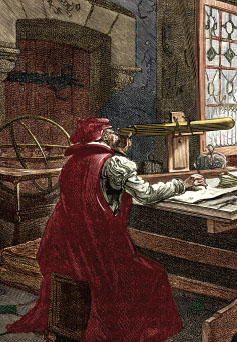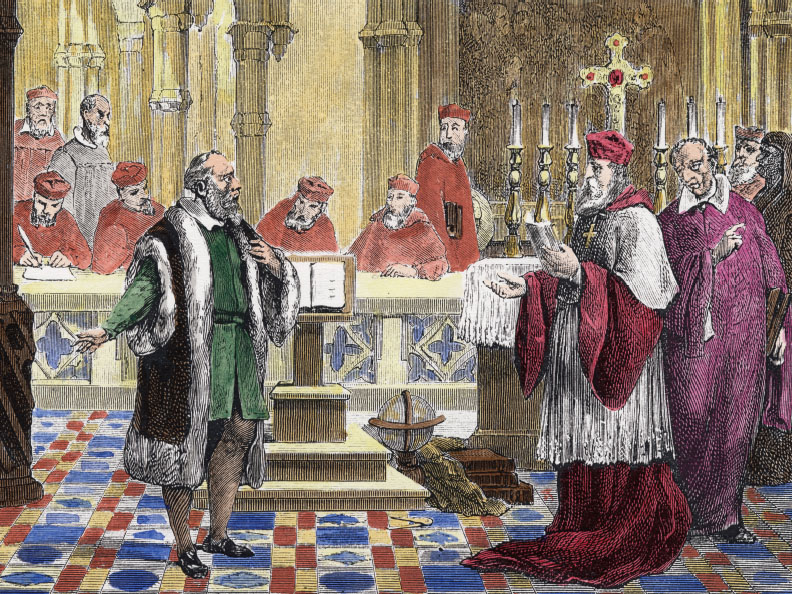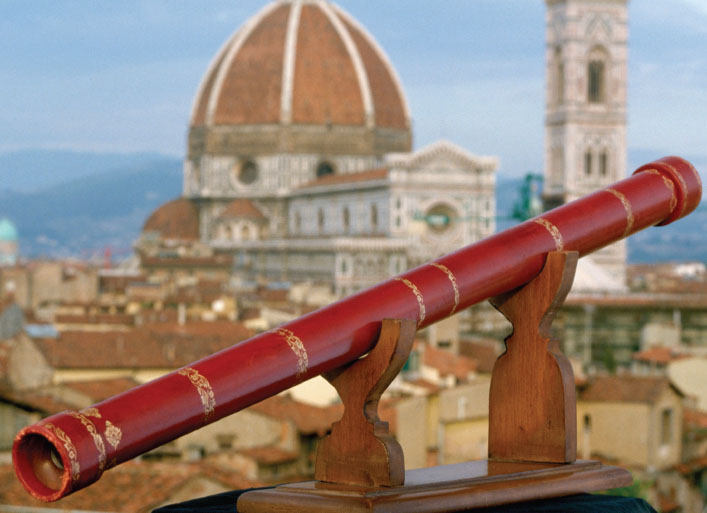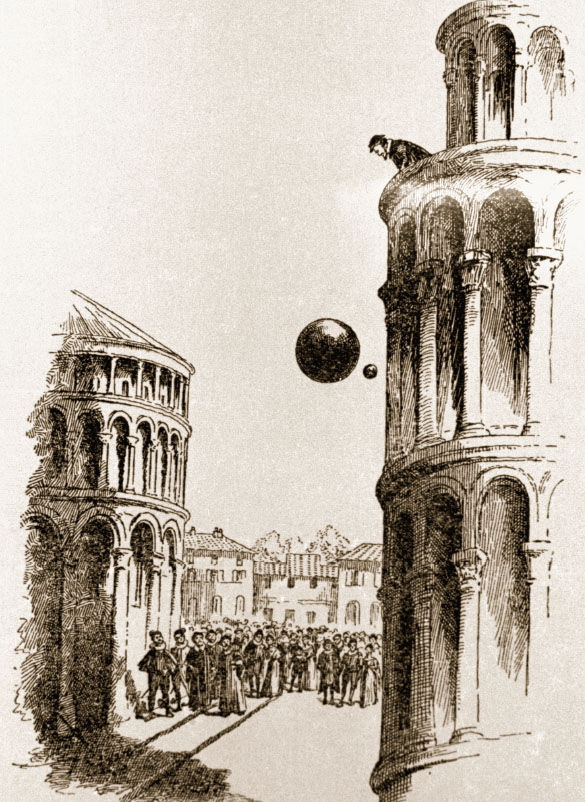Galileo Galilei
1564–1642
Galileo Galilei (1564–1642) was the first great scientist of the modern age. His insistence on observation and experiment laid the foundations for the scientific revolution of the seventeenth century. The force of his ideas, however, would bring him into head-on conflict with the Roman Catholic Church.

A BRILLIANTLY CREATIVE MAN, GALILEO ACHIEVED MANY SCIENTIFIC FIRSTS, each of which would have been enough to give him a place in history. For one thing, he was an ingenious inventor, and among the most notable of his ideas was the value of the pendulum as a timekeeper, which led to the creation of the first accurate clocks. Another Galileo invention was the thermometer. He invented the sector, too, the first simple device for calculating the trajectory of a missile. And he could be said to have invented the astronomical telescope.
Above all, though, he was a great scientist. For example, he did not simply take the telescope and turn it into a major scientific instrument. He had the insight to use it to look at the night sky and make many extraordinary discoveries there – including the mountains and valleys on the Moon’s surface; the moons of Jupiter; the fact that Venus has phases like the Moon; and the Sun has spots. It was these discoveries that persuaded Galileo that Copernicus’s view that the Sun and not the Earth was at the centre of the universe was true. This led to his clash with the Catholic Church, which insisted on the old Ptolemaic view of the universe, in which the Earth is fixed immobile at its centre.
But perhaps Galileo’s greatest achievements were in understanding how things move, which created the basis for the modern science of physics. For almost 2,000 years, people had accepted the views of Aristotle on how things fall, why things stop and go, and how things get faster and slower – and remained blind to the evidence of their senses. Galileo overturned Aristotle’s apparently common-sense views – and paved the way for Newton’s full understanding of force, motion and gravity half a century later.
It was Galileo’s insistence on the importance of demonstration, observation and experiment that proved Aristotle wrong, and led to insights and proofs of entirely new ideas. Galileo was not alone at the time in looking at things this way. The English thinker Francis Bacon was a pioneer of these new methods. However, Galileo put them into practice with such force and insight, and with such crucial effect, that he deserves to be called, as he often is, ‘the father of modern science’.
The young Galileo
Galileo Galilei was born in Pisa in Italy on 15 February 1564. His father Vincenzo was descended from a Florentine family that had fallen on hard times. Vincenzo was a musician of some talent and a highly independent, combative turn of mind, which the flame-haired Galileo inherited.
At the age of 10, the young Galileo was sent to school at the monastery of Vallombrosa. He took so well to the monastic life that at 14 his father took him away from the school, worried that his son might take up the life of a poor man of the cloth. He spent a few years with tutors in Florence, and then his father brought him back home to study medicine at Pisa University.
The young Galileo began to challenge his teachers. He would stand up and question lecturers on the absurd fixity of their ideas, which came largely from Aristotle. Why, Galileo would ask, do hailstones all hit the ground at the same speed if heavier things fall faster, as Aristotle said? And then he would laugh when the lecturer tried to suggest it might be because heavier stones come from higher up. Clearly, as Vincenzo realized, Galileo would never possess the calm bedside manner of a doctor.
Then Galileo discovered mathematics – and the works of the Greek geometer Euclid (see here). Euclid insisted on clear proofs and demonstrations before anything could be accepted as true – and this idea stuck with Galileo for the rest of his life. He was also struck by how that other great Greek mathematician, Archimedes, had begun to apply this approach to science as well as mathematics. ‘Those who read his works,’ Galileo wrote, ‘realize only too clearly how inferior all other minds are.’
Discovering mathematics
Vincenzo arranged for Galileo to be tutored in mathematics by the brilliant Florentine court mathematician Ostilio Ricci, and Galileo quickly outshone his teacher. Even at this young age, Galileo was highly inventive. According to one story, he was sitting through a dull sermon in Pisa Cathedral one Sunday, idly watching a lamp swinging on a long wire. He suddenly noticed that no matter how wide the lamp swung, it always completed its swing in exactly the same time. Proving this with a series of simple experiments at home, he realized that it could be used to make a timing device, which he called a pulsilogium, because it could be used to time a patient’s pulse. This later became the basis for the pendulum clock.
At the age of 21, Galileo began to teach mathematics, and this was to be his main source of income for the remainder of his life. At first he tutored privately. Later he was appointed lecturer at Pisa University, but the pay was poor. When his father died in 1591 and Galileo was left with the whole family to support, he moved to a better-paid post at Padua and remained there for 18 years. He was a distinctive figure who strode around the precincts in dishevelled clothes and without the regulation academic gown. It was in Padua that Galileo took up with Marina Gamba, a fiery back-street beauty who was described in the slang of the day as una donna di facile costume (a girl whose clothes come off easily). They never actually lived together, or married, but they had three children and were effectively a family.
In between his teaching work, Galileo began to investigate scientific problems that took his interest. His first ideas on how things move were encapsulated in 1590 in a series of essays called De motu, written while he was at Pisa. It was while working on this that he conducted his famous experiment on the Leaning Tower of Pisa. To show the error of Aristotle’s notion that heavier things fall faster, he dropped cannonballs of different sizes and weights from the tower’s overhang and showed beyond doubt that they land at the same time. These ideas were later developed in La meccaniche, which combined mathematics and physics to create the new science of mechanics – the science of force and motion.
Galileo’s telescope
Sometime in the summer of 1609, Galileo visited Venice and became intrigued by a novelty called a perspicillium, made by a Dutch spectacle-maker. It consisted of two lenses in a tube and could make a distant steeple look as if it was just across the way. Inspired, Galileo realized how it worked and immediately made one of his own with ten times as much magnification. He called it a telescope and it rapidly became famous throughout Italy.

Galileo’s trial for heresy by the Catholic Church. Threatened with death, Galileo finally renounced his views on 22 June 1633. He was imprisoned in his villa at Arcetri. In 1642 the Church refused to bury his body on consecrated ground. His conviction was finally annulled in 1992.
In a stroke of genius, Galileo used his telescope at night to look at the Moon and the stars. At once he saw the Moon was not the perfect sphere it was supposed at the time to be, but had mountains, valleys, cliffs and maybe even seas. Soon he discovered that Jupiter was not the perfect isolated sphere it was supposed to be either, but actually had four moons of its own. And then he noticed that Venus went through phases, just like the Moon, as our view of it from Earth changes. In 1610, Galileo published all these discoveries in a stylish work in Latin called The Starry Messenger.
Galileo against the Church
Galileo’s discoveries clearly implied that the Earth was not at the centre of the universe, as most people believed then, but moved round the Sun, as Copernicus had suggested 70 years earlier. However, there was no mention of this in The Starry Messenger. By the time he moved to Florence to become ‘philosopher and mathematician’ at the court of Grand Duke Cosimo de Medici, Galileo was certainly convinced that Copernicus was right, and was saying things like, ‘Earthly laws apply to the heavens’.
Rival academics were still firmly wedded to Ptolemy’s model of the universe, which put the Earth immobile at the centre, with the Sun, Moon, planets and stars revolving in perfect, unblemished layers around it. These ideas fitted in neatly with the Bible, leaving the realm of the heavens purely in God’s control. Galileo’s beliefs could be seen as heretical, and he was denounced to the Inquisition as a blasphemer.

Reproduction of Galileo’s telescope, with the cathedral of Florence in the background.
These were highly dangerous times for heretics. It was barely 30 years since the astronomer Giordano Bruno had been burned at the stake for his ideas. So Galileo went to Rome in 1616 to plead his case. His pleas fell on deaf ears. Copernicus’s book (see here) was banned at once and Galileo was sent back to Florence with a stern warning not to ‘hold or defend’ Copernican ideas. However, when the apparently more sympathetic Urban VIII became pope in 1624, Galileo went back to Rome to put his case again. Urban said that Galileo might write about ‘systems of the world’ as long as he did not defend Copernicanism.
At once, Galileo – by now over 60 years old – began writing a book in the form of a dialogue between three characters: the clever Sagredo (who argues for Copernicus), the dullard Simplicio (who argues hopelessly for Aristotle) and Salviati (who takes an apparently neutral line but is clearly for Sagredo). Called The Dialogue, the book was an instant success across Europe. Then the Jesuits pointed out to the pope that the ridiculous Simplicio might be based on him. At once Galileo was dragged back to Rome by the furious pope. There he was quickly forced by the papal authorities to deny – maybe under threat of torture – that the Earth moves round the Sun, and was sent away to be imprisoned in his own house for the rest of his life. Legend has it that as he was led away, he muttered ‘eppir si muove’ (yet it does move).
Despite his age and ailing health, Galileo continued to do scientific research. In 1637, just before he went completely blind, he saw through his telescope that the moon wobbles on its axis. He eventually died on 8 January 1642, the same year that Newton was born in England. It took the Vatican 350 years to admit that ‘errors might have been made’ in the case of Galileo, but they need not have bothered. Even as he was carried to his grave, the scientific revolution begun by the Italian genius was getting into its stride, despite the pope’s opposition.

‘They were seen to fall evenly’: the original caption to an illustration of Galileo’s famous – if probably apocryphal – experiment on the velocity of falling bodies from the Leaning Tower of Pisa.
Galileo and motion
The philosophers of ancient Greece had known a great deal about statics – that is, about things that are not moving. But they were often lost when it came to questions of dynamics, or how things move. They could see, for instance, that a cart moves because the horse pulls it. They could see, too, that an arrow flies because of the power of the bow. But they had no explanation for why an arrow goes on flying through the air when there is nothing to pull it like the horse pulls the cart. The famous Greek philosopher Aristotle made the common-sense assumption that there must be a force to keep something moving – just as a bike will only keep on moving if the rider pushes on the pedals.
But common sense can be wrong, and it was Galileo’s genius to see the superiority of practical observation and experiment, or cimento as he called them, over common sense. After a series of cimento – many involving rolling balls down slopes – Galileo realized that force was not needed to keep something moving. Exactly the opposite is true: something will keep moving at the same speed unless a force slows it down. This is why the arrow goes on flying through the air. It only falls to the ground because the resistance of the air (a force) slows it down enough for it to be pulled to the ground by gravity (another force). This is the principle of inertia.
Galileo resisted the notion of gravity because he felt the idea of what seemed to be a mystical force was unconvincing, but he was the first to appreciate the concept of inertia and verify it experimentally. He realized that there is no real difference between something that is moving at a steady speed and something that is not moving at all – both are unaffected by forces. But to make the object go faster or slower, or begin to move, a force is needed.
Further experiments, this time with swinging weights, led Galileo to a second crucial insight. In these experiments, he began to appreciate the notion of acceleration, and just what causes it. If something moves faster, he realized, then the rate at which it accelerates depends on the strength of the force that is moving it faster, and how heavy the object is. A large force accelerates a light object rapidly, while a small force accelerates a heavy object slowly.
These insights of Galileo’s were very similar to the first 2 of the 3 laws of motion that Newton described 46 years later in his Principia (see here). It is even possible that Galileo was aware of the third law – about action and reaction. Although he did not formulate his ideas with the same grand clarity and mathematical certainty of Newton, he did lay the foundations of our modern understanding of how things move.